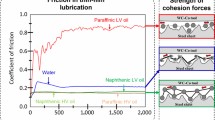Abstract
Deterioration of the lubricant performance of oils due to water incorporation is a major cause of failure during prolonged operation of mechanical assemblies. However, early indication of lubricant failure is challenging. In this work, a quartz crystal microbalance (QCM) technique was used to sense changes in oil characteristics and degradation upon water incorporation. The results obtained during runs at different temperatures indicate stronger signs of oil degradation with larger amount of water mixed in it. The observations on the lubrication performance of water-containing lubricants were confirmed by evaluating the effect of water incorporation on the tribological performance of steel surfaces immersed in synthetic oil. Macroscale tribological analysis indicated an increase in friction and wear of sliding steel components lubricated with water-containing oil after longer durations of tests. The results of this study provide new insights into how early signs of oil degradation can be sensed using the QCM technique toward minimizing the potential negative impact of such changes on the lubrication characteristics of oils.







Similar content being viewed by others
References
Holmberg, K., Andersson, P., Erdemir, A.: Global energy consumption due to friction in passenger cars. Tribol. Int. 47, 221–234 (2012)
Khonsari, M.M., Booser, E.R.: Applied Tribology: Bearing Design and Lubrication. Wiley, New York (2001)
Park, J.Y., Salmeron, M.: Fundamental aspects of energy dissipation in friction. Chem. Rev. 114(1), 677–711 (2013)
Berman, D., Erdemir, A., Sumant, A.V.: Approaches for achieving superlubricity in two-dimensional materials. ACS Nano 12(3), 2122–2137 (2018)
Olsson, H., Åström, K.J., De Wit, C.C., Gäfvert, M., Lischinsky, P.: Friction models and friction compensation. Eur. J. Control 4(3), 176–195 (1998)
Li, X., Teitgen, A.M., Shirani, A., Ling, J., Busta, L., Cahoon, R.E., Zhang, W., Li, Z., Chapman, K.D., Berman, D., Zhang, C., Minto, R.E., Cahoon, E.B.: Discontinuous fatty acid elongation yields hydroxylated seed oil with improved function. Nat. Plants 4(9), 711–720 (2018)
Chang, Q., Rudenko, P., Miller, D.J., Wen, J., Berman, D., Zhang, Y., Arey, B., Zhu, Z., Erdemir, A.: Operando formation of an ultra-low friction boundary film from synthetic magnesium silicon hydroxide additive. Tribol. Int. 110, 35–40 (2017)
Bartz, W.J.: Engine Oils and Automotive Lubrication. Routledge, London (2019)
Bartz, W.J.: Lubricants and the environment. Tribol. Int. 31(1), 35–47 (1998)
Smith, F.: Lubricant behaviour in concentrated contact systems—the castor oil–steel system. Wear 2(4), 250–263 (1959)
Berman, D., Erdemir, A., Sumant, A.V.: Graphene: a new emerging lubricant. Mater. Today 17(1), 31–42 (2014)
Erdemir, A.: Solid lubricants and self-lubricating films. In: Bhushan, B. (ed.) Handbook of Modern Tribology, pp. 787–818. CRC Press, Boca Raton (2001)
Hamrock, B.J., Schmid, S.R., Jacobson, B.O.: Fundamentals of Fluid Film Lubrication. CRC Press, Boca Raton (2004)
Erdemir, A., Ramirez, G., Eryilmaz, O.L., Narayanan, B., Liao, Y., Kamath, G., Sankaranarayanan, S.K.R.S.: Carbon-based tribofilms from lubricating oils. Nature 536(7614), 67–71 (2016)
Szeri, A.Z.: Tribology: Friction, Lubrication, and Wear. Hemisphere, Washington (1980)
Kokal, S.L.: Crude oil emulsions: a state-of-the-art review. SPE Prod. Facil. 20(01), 5–13 (2005)
Adiga, K., Shah, D.: On the vaporization behavior of water-in-oil microemulsions. Combust. Flame 80(3–4), 412–414 (1990)
Yang, W., An, H., Chou, S., Chua, K., Mohan, B., Sivasankaralingam, V., Raman, V., Maghbouli, A., Li, J.: Impact of emulsion fuel with nano-organic additives on the performance of diesel engine. Appl. Energy 112, 1206–1212 (2013)
Wilson, W., Sakaguchi, Y., Schmid, S.: A dynamic concentration model for lubrication with oil-in-water emulsions. Wear 161(1–2), 207–212 (1993)
Kimura, Y., Okada, K.: Lubricating properties of oil-in-water emulsions. Tribol. Trans. 32(4), 524–532 (1989)
Cantley, R.E.: The effect of water in lubricating oil on bearing fatigue life. ASLE Trans. 20(3), 244–248 (1977)
Hamaguchi, H., Spikes, H.A., Cameron, A.: Elastohydrodynamic properties of water in oil emulsions. Wear 43(1), 17–24 (1977)
Cambiella, A., Benito, J.M., Pazos, C., Coca, J., Ratoi, M., Spikes, H.A.: The effect of emulsifier concentration on the lubricating properties of oil-in-water emulsions. Tribol. Lett. 22(1), 53 (2006)
Lee, J., Berman, D.: Inhibitor or promoter: insights on the corrosion evolution in a graphene protected surface. Carbon 126, 225–231 (2018)
Lee, J., Atmeh, M., Berman, D.: Effect of trapped water on the frictional behavior of graphene oxide layers sliding in water environment. Carbon 120, 11–16 (2017)
Berman, D., Krim, J.: Impact of oxygen and argon plasma exposure on the roughness of gold film surfaces. Thin Solid Films 520(19), 6201–6206 (2012)
She, Y., Lee, J., Lee, B., Diroll, B., Scharf, T., Shevchenko, E.V., Berman, D.: Effect of the micelle opening in self-assembled amphiphilic block co-polymer films on the infiltration of inorganic precursors. Langmuir 35(3), 796–803 (2019)
She, Y., Lee, J., Diroll, B.T., Scharf, T.W., Shevchenko, E.V., Berman, D.: Accessibility of the pores in highly porous alumina films synthesized via sequential infiltration synthesis. Nanotechnology 29(49), 495703 (2018)
Acharya, B., Sidheswaran, M.A., Yungk, R., Krim, J.: Quartz crystal microbalance apparatus for study of viscous liquids at high temperatures. Rev. Sci. Instrum. 88(2), 025112 (2017)
Rodahl, M., Höök, F., Kasemo, B.: QCM operation in liquids: an explanation of measured variations in frequency and Q factor with liquid conductivity. Anal. Chem. 68(13), 2219–2227 (1996)
Hsu, S.M., Gates, R.S.: Boundary lubricating films: formation and lubrication mechanism. Tribol. Int. 38(3), 305–312 (2005)
Fuchs, G., Diamond, H.: Oxidation characteristics of lubricating oils. Ind. Eng. Chem. 34(8), 927–937 (1942)
Lahijani, J., Lockwood, F., Klaus, E.: The influence of metals on sludge formation. ASLE Trans. 25(1), 25–32 (1982)
Acknowledgements
This work was performed in part at the University of North Texas’ Materials Research Facility. Support from the Advanced Materials and Manufacturing Processes Institute (AMMPI) at the University of North Texas is acknowledged.
Author information
Authors and Affiliations
Corresponding author
Additional information
Publisher's Note
Springer Nature remains neutral with regard to jurisdictional claims in published maps and institutional affiliations.
Rights and permissions
About this article
Cite this article
Jacques, K., Joy, T., Shirani, A. et al. Effect of Water Incorporation on the Lubrication Characteristics of Synthetic Oils. Tribol Lett 67, 105 (2019). https://doi.org/10.1007/s11249-019-1217-0
Received:
Accepted:
Published:
DOI: https://doi.org/10.1007/s11249-019-1217-0




